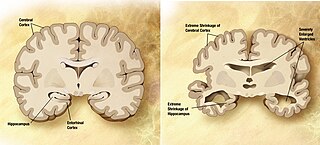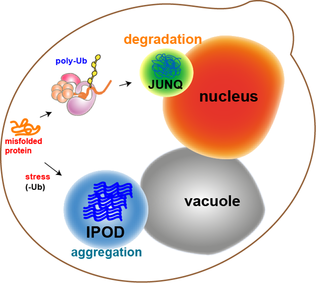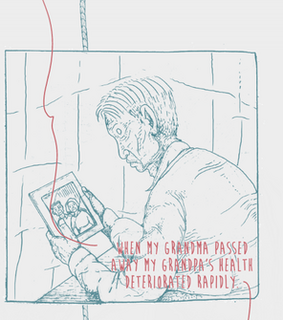 W
WAlpha secretases are a family of proteolytic enzymes that cleave amyloid precursor protein (APP) in its transmembrane region. Specifically, alpha secretases cleave within the fragment that gives rise to the Alzheimer's disease-associated peptide amyloid beta when APP is instead processed by beta secretase and gamma secretase. The alpha-secretase pathway is the predominant APP processing pathway. Thus, alpha-secretase cleavage precludes amyloid beta formation and is considered to be part of the non-amyloidogenic pathway in APP processing. Alpha secretases are members of the ADAM family, which are expressed on the surfaces of cells and anchored in the cell membrane. Several such proteins, notably ADAM10, have been identified as possessing alpha-secretase activity. Upon cleavage by alpha secretases, APP releases its extracellular domain - a fragment known as APPsα - into the extracellular environment in a process known as ectodomain shedding.
 W
WAloysius Alzheimer was a German psychiatrist and neuropathologist and a colleague of Emil Kraepelin. Alzheimer is credited with identifying the first published case of "presenile dementia", which Kraepelin would later identify as Alzheimer's disease.
 W
WAlzheimer's disease (AD), also referred to simply as Alzheimer's, is a neurodegenerative disease that usually starts slowly and gradually worsens over time. It is the cause of 60–70% of cases of dementia. The most common early symptom is difficulty in remembering recent events. As the disease advances, symptoms can include problems with language, disorientation, mood swings, loss of motivation, self-neglect, and behavioural issues. As a person's condition declines, they often withdraw from family and society. Gradually, bodily functions are lost, ultimately leading to death. Although the speed of progression can vary, the typical life expectancy following diagnosis is three to nine years.
 W
WAmyloid-beta precursor protein (APP) is an integral membrane protein expressed in many tissues and concentrated in the synapses of neurons. It functions as a cell surface receptor and has been implicated as a regulator of synapse formation, neural plasticity, antimicrobial activity, and iron export. It is coded for by the gene APP and is best known as the precursor molecule whose proteolysis generates amyloid beta (Aβ), a polypeptide containing 37 to 49 amino acid residues, whose amyloid fibrillar form is the primary component of amyloid plaques found in the brains of Alzheimer's disease patients.
 W
WAmyloid-related imaging abnormalities (ARIA) are abnormal differences seen in neuroimaging of Alzheimer's Disease patients, associated with amyloid-modifying therapies, particularly human monoclonal antibodies such as aducanumab. There are two types of ARIA - ARIA-E and ARIA-H. The phenomenon was first seen in trials of bapineuzumab.
 W
WApolipoprotein E (APOE) is a protein involved in the metabolism of fats in the body of mammals. A subtype is implicated in Alzheimer's disease and cardiovascular disease.
 W
WAxona was previously marketed as a medical food for the clinical dietary management of the impairment of metabolic processes associated with mild to moderate Alzheimer's disease. It is a proprietary formulation of fractionated palm kernel oil, a medium-chain triglyceride. Cericin, the company that makes Axona, states that during digestion, caprylic triglyceride is broken down into ketones, which provide an alternative energy source for the brain. Its use is based on the idea that the brain's ability to use its normal energy source, glucose, is impaired in Alzheimer's disease. Axona was first sold in March 2009.
 W
WAmyloid beta denotes peptides of 36–43 amino acids that are the main component of the amyloid plaques found in the brains of people with Alzheimer's disease. The peptides derive from the amyloid precursor protein (APP), which is cleaved by beta secretase and gamma secretase to yield Aβ. Aβ molecules can aggregate to form flexible soluble oligomers which may exist in several forms. It is now believed that certain misfolded oligomers can induce other Aβ molecules to also take the misfolded oligomeric form, leading to a chain reaction akin to a prion infection. The oligomers are toxic to nerve cells. The other protein implicated in Alzheimer's disease, tau protein, also forms such prion-like misfolded oligomers, and there is some evidence that misfolded Aβ can induce tau to misfold.
 W
WBeta-secretase 1, also known as beta-site amyloid precursor protein cleaving enzyme 1, beta-site APP cleaving enzyme 1 (BACE1), membrane-associated aspartic protease 2, memapsin-2, aspartyl protease 2, and ASP2, is an enzyme that in humans is encoded by the BACE1 gene. Expression of BACE1 is observed mainly in neurons.
 W
WBradyphrenia is the slowness of thought common to many disorders of the brain. Disorders characterized by bradyphrenia include Parkinson's disease and forms of schizophrenia consequently causing a delayed response and fatigue. Patients with bradyphrenia may describe or may manifest slowed thought processes, evidenced by increased latency of response and also involve severe memory impairment and poor motor control. The word 'bradyphrenia' originates from the ancient Greek meaning 'slow mind.'
 W
WDementia and Alzheimer's disease in Australia is a major health issue. Alzheimer's disease is the most common type of dementia in Australia. Dementia is an ever-increasing challenge as the population ages and life expectancy increases. As a consequence, there is an expected increase in the number of people with dementia, posing countless challenges to carers and the health and aged care systems. In 2018, an estimated 376,000 people had dementia; this number is expected to increase to 550,000 by 2030 and triple to 900,000 by 2050. The dementia death rate is increasing, resulting in the shift from fourth to second leading cause of death from 2006 to 2015. It is expected to become the leading cause of death over the next number of years. In 2011, it was the fourth leading cause of disease burden and third leading cause of disability burden. This is expected to remain the same until at least 2020.
 W
WAuguste Deter was a German woman notable for being the first person to be diagnosed with Alzheimer's disease.
 W
WFlutemetamol (18F) is a PET scanning radiopharmaceutical containing the radionuclide fluorine-18, used as a diagnostic tool for Alzheimer's disease.
 W
WGRB2-associated-binding protein 2 also known as GAB2 is a protein that in humans is encoded by the GAB2 gene.
 W
WGamma secretase is a multi-subunit protease complex, itself an integral membrane protein, that cleaves single-pass transmembrane proteins at residues within the transmembrane domain. Proteases of this type are known as intramembrane proteases. The most well-known substrate of gamma secretase is amyloid precursor protein, a large integral membrane protein that, when cleaved by both gamma and beta secretase, produces a short 37-43 amino acid peptide called amyloid beta whose abnormally folded fibrillar form is the primary component of amyloid plaques found in the brains of Alzheimer's disease patients. Gamma secretase is also critical in the related processing of several other type I integral membrane proteins, such as Notch, ErbB4, E-cadherin, N-cadherin, ephrin-B2, or CD44.
 W
WHumanin is a micropeptide encoded in the mitochondrial genome by the 16S ribosomal RNA gene, MT-RNR2. Its structure contains a three-turn α-helix, and no symmetry.
 W
WJUNQ and IPOD are types of cytosolic protein inclusion bodies in eukaryotes.
 W
WLevomilnacipran is an antidepressant which was approved in the United States in 2013 for the treatment of major depressive disorder (MDD) in adults. It is the levorotatory enantiomer of milnacipran, and has similar effects and pharmacology, acting as a serotonin–norepinephrine reuptake inhibitor (SNRI).
 W
WMilnacipran is a serotonin–norepinephrine reuptake inhibitor (SNRI) used in the clinical treatment of fibromyalgia. It is not approved for the clinical treatment of major depressive disorder in the US, but it is in other countries.
 W
WNeprilysin, also known as membrane metallo-endopeptidase (MME), neutral endopeptidase (NEP), cluster of differentiation 10 (CD10), and common acute lymphoblastic leukemia antigen (CALLA) is an enzyme that in humans is encoded by the MME gene. Neprilysin is a zinc-dependent metalloprotease that cleaves peptides at the amino side of hydrophobic residues and inactivates several peptide hormones including glucagon, enkephalins, substance P, neurotensin, oxytocin, and bradykinin. It also degrades the amyloid beta peptide whose abnormal folding and aggregation in neural tissue has been implicated as a cause of Alzheimer's disease. Synthesized as a membrane-bound protein, the neprilysin ectodomain is released into the extracellular domain after it has been transported from the Golgi apparatus to the cell surface.
 W
WNeurofibrillary tangles (NFTs) are aggregates of hyperphosphorylated tau protein that are most commonly known as a primary marker of Alzheimer's disease. Their presence is also found in numerous other diseases known as tauopathies. Little is known about their exact relationship to the different pathologies.
 W
WNicastrin, also known as NCSTN, is a protein that in humans is encoded by the NCSTN gene.
 W
WThe nucleus basalis, also known as the nucleus basalis of Meynert or nucleus basalis magnocellularis, is a group of neurons located mainly in the substantia innominata of the basal forebrain. Most neurons of the nucleus basalis are rich in the neurotransmitter acetylcholine, and they have widespread projections to the neocortex and other brain structures.
 W
WOxidative stress reflects an imbalance between the systemic manifestation of reactive oxygen species and a biological system's ability to readily detoxify the reactive intermediates or to repair the resulting damage. Disturbances in the normal redox state of cells can cause toxic effects through the production of peroxides and free radicals that damage all components of the cell, including proteins, lipids, and DNA. Oxidative stress from oxidative metabolism causes base damage, as well as strand breaks in DNA. Base damage is mostly indirect and caused by reactive oxygen species (ROS) generated, e.g. O2− (superoxide radical), OH (hydroxyl radical) and H2O2 (hydrogen peroxide). Further, some reactive oxidative species act as cellular messengers in redox signaling. Thus, oxidative stress can cause disruptions in normal mechanisms of cellular signaling.
 W
Wp3 peptide also known as amyloid β- peptide (Aβ)17–40/42 is the peptide resulting from the α- and γ-secretase cleavage from the amyloid precursor protein (APP). It is known to be the major constituent of diffuse plaques observed in Alzheimer's disease (AD) brains and pre-amyloid plaques in people affected of Down syndrome. However, p3 peptide's role in these diseases is not truly known yet.
 W
WPEN-2 is a protein that is a regulatory component of the gamma secretase complex, a protease complex responsible for proteolysis of transmembrane proteins such as the Notch protein and amyloid precursor protein (APP). The gamma secretase complex consists of PEN-2, APH-1, nicastrin, and the catalytic subunit presenilin. PEN-2 is a 101-amino acid integral membrane protein likely with a topology such that both the N-terminus and the C-terminus face first the lumen of the endoplasmic reticulum and later the extracellular environment. Biochemical studies have shown that a conserved sequence motif D-Y-L-S-F at the C-terminus, as well as the overall length of the C-terminal tail, is required for the formation of an active gamma secretase complex.
 W
WPrimary progressive aphasia (PPA) is a type of neurological syndrome in which language capabilities slowly and progressively become impaired. As with other types of aphasia, the symptoms that accompany PPA depend on what parts of the left hemisphere are significantly damaged. However, unlike most other aphasias, PPA results from continuous deterioration in brain tissue, which leads to early symptoms being far less detrimental than later symptoms. Those with PPA slowly lose the ability to speak, write, read, and generally comprehend language. Eventually, almost every patient becomes mute and completely loses the ability to understand both written and spoken language. Although it was first described as solely impairment of language capabilities while other mental functions remain intact, it is now recognized that many, if not most of those afflicted suffer from impairment of memory, short term memory formation and loss of executive functions. It was first described as a distinct syndrome by M.‑Marsel Mesulam in 1982. Primary progressive aphasias have a clinical and pathological overlap with the frontotemporal lobar degeneration (FTLD) spectrum of disorders and Alzheimer's disease. However, PPA is not considered synonymous to Alzheimer's disease due to the fact that, unlike those affected by Alzheimer's disease, those with PPA are generally able to maintain the ability to care for themselves, remain employed, and pursue interests and hobbies. Moreover, in diseases such as Alzheimer's disease, Pick's disease, and Creutzfeldt-Jakob disease, progressive deterioration of comprehension and production of language is just one of the many possible types of mental deterioration, such as the progressive decline of memory, motor skills, reasoning, awareness, and visuospatial skills.
 W
WProtein aggregation is a biological phenomenon in which intrinsically disordered proteins or mis-folded proteins aggregate either intra- or extracellularly. Mis-folded protein aggregates are often correlated with diseases. In fact, protein aggregates have been implicated in a wide variety of disease known as amyloidoses, including ALS, Alzheimer's, Parkinson's and prion disease.
 W
WSemagacestat (LY-450139) was a candidate drug for a causal therapy against Alzheimer's disease. It was originally developed by Eli Lilly and Elan, and clinical trials were conducted by Eli Lilly. Phase III trials included over 3000 patients, but in August 2010, a disappointing interim analysis, in which semagacestat performed worse than the placebo, led to the trials being stopped.
 W
WSortilin-related receptor, L(DLR class) A repeats containing is a protein that in humans is encoded by the SORL1 gene.
 W
WThese Memories Won't Last is a 2015 webcomic created by Stu Campbell. The infinite canvas webcomic written in HTML5 tells the story of Campbell's grandfather suffering from Alzheimer's disease. These Memories Won't Last is deliberately created to work with current web browser software and will likely not be readable with future technologies. The webcomic was nominated for an Eisner Award.
 W
WType 3 diabetes is a proposed term to describe the interlinked association between type 1 and type 2 diabetes, and Alzheimer's disease. This term is used to look into the triggers of Alzheimer's disease in people with diabetes.